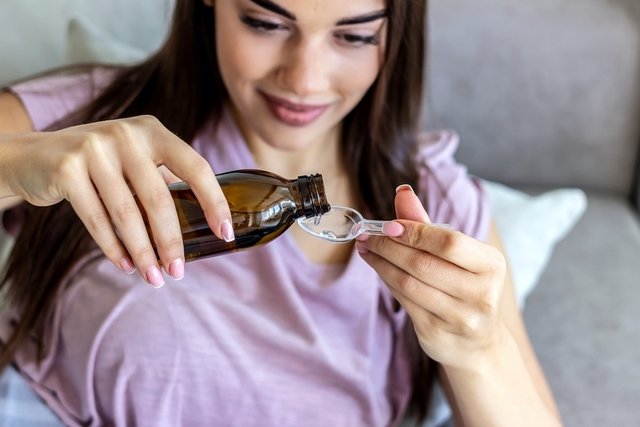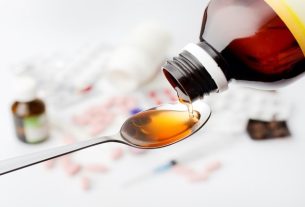Transpulmin is an expectorant and mucolytic medicine indicated to reduce the symptoms of coughing with phlegm, caused by flu or colds, as it acts by making the phlegm more liquid and looser, facilitating its elimination through the respiratory tract, and can also be used to help relieve nasal congestion.
This remedy can be found in pharmacies or drugstores in the form of an adult or children’s syrup containing guaifenesin in its composition, or in the form of a balm or suppository, containing camphor, eucalyptol, menthol and guaiacol, and can be used by adults or children over the age of 2 years old.
Although it is sold without a prescription, it is important to use Transpulmin with medical advice, especially for children.
What is it for
Transpulmin syrup or suppository is indicated for the relief of coughing with phlegm caused by flu or colds, due to its expectorant and mucolytic action, which helps to make the phlegm more liquid and looser, facilitating its elimination.
Transpulmin balm is an ointment intended for the temporary relief of nasal congestion and cough, associated with flu and colds.
How to use
How to use Transpulmin depends on the presentation and includes:
1. Transpulmin xarope adult 200 mg/15 mL
Transpulmin adult syrup contains 200 mg of guaifenesin for every 15 mL of syrup, with a mint flavor, and must be taken orally using the measuring cup provided in the packaging to measure the right volume of the medicine.
Recommended doses of Transpulmin adult syrup depend on age and include:
- Adults or children over 12 years old: the recommended dose is 15 mL of syrup for adults, every 4 hours, which corresponds to 200 mg of guaifenesin per dose;
- Children aged 6 to 12: the recommended dose is 7.5 mL of adult syrup (half a measuring cup), which corresponds to 100 mg of guaifenesin per dose, taken every 4 hours;
- Children aged 2 to 6 years: the recommended dose is 5 mL of adult syrup, which corresponds to 66.7 mg of guaifenesin, taken every 4 hours.
The maximum recommended daily dose for adults or children over 12 years of age is 2400 mg per day, for children aged 6 to 12 years it is 1200 mg per day and for children aged 2 to 6 years it is 600 mg per day.
Transpulmin adult syrup should be used with medical advice, according to symptoms, on an individual basis.
2. Transpulmin children’s xarope 100 mg/ 15 mL
Transpulmin children’s syrup contains 100 mg of guaifenesin for every 15 mL of syrup, with a honey flavor, and must be taken orally using the measuring cup provided in the packaging to measure the right volume of the medicine.
Recommended doses of Transpulmin children’s syrup depend on age and include:
- Children aged 6 to 12: the recommended dose is 15 mL of children’s syrup, which corresponds to 100 mg of guaifenesin per dose, taken every 4 hours, as advised by the pediatrician;
- Children aged 2 to 6 years: the recommended dose is 7.5 mL of children’s syrup (half a measuring cup), which corresponds to 50 mg of guaifenesin, taken every 4 hours, as instructed by the pediatrician.
The maximum recommended daily dose of Transpulmin children’s syrup for children aged 6 to 12 years is 1200 mg per day and for children aged 2 to 6 years it is 600 mg per day.
Transpulmin children’s syrup should always be used with the advice of a pediatrician, who should advise the dose and treatment time.
2. Transpulmin balm
Transpulmin balm is an ointment that can be used by adults or children over 2 years of age, applying approximately 4 cm of the balm to the skin of the chest and back, massaging, approximately 3 to 4 times a day or depending on the doctor’s guidance.
4 applications per day should not be exceeded and the balm should not be applied directly to the nostrils or face.
3. Transpulmin suppository
Transpulmin suppository must be applied rectally or anally, in children over 2 years of age, and the recommended dose is to apply 1 suppository 1 to 2 times a day, as instructed by the pediatrician. The maximum dose is 2 suppositories per day and should not be exceeded.
Before using the suppository, the pack must be placed in the refrigerator for around 5 minutes. Then, the suppository must be introduced rectally. Learn how to apply children’s suppositories.
Possible side effects
Transpulmin syrup is well tolerated, however, although rare, side effects such as nausea, vomiting, diarrhea, stomach pain, stone formation in the urinary tract, headache, drowsiness or dizziness may occur. Furthermore, Transpulmin syrup can cause allergic reactions with the formation of blisters on the skin and hives, in which case it is important to stop treatment and seek medical help immediately.
Transpulmin balm can cause burning at the site of application due to skin irritation, itching, blistering or swelling of the skin.
As for suppositories, although it is rare, diarrhea, vomiting, intestinal discomfort or drowsiness may occur.
Who shouldn’t use
Transpulmin should not be used by children under 2 years of age or by people who are allergic to any of the components present in the formula. Furthermore, it can only be used by pregnant women if recommended by a doctor.
In the case of Transpulmin syrup, which has guaifenesin in its composition, it should not be used by people with porphyria. Furthermore, it should be used with caution by diabetics, because it contains sugar in its composition.
Transpulmin suppository should also not be used by people with gastrointestinal or bile duct inflammation, or by people with gallstones or liver disease.
If after 7 days of treatment, the cough still persists or is accompanied by fever, rash, continuous headache or sore throat, you should see a doctor.

Sign up for our newsletter and stay up to date with exclusive news
that can transform your routine!
Warning: Undefined array key "title" in /home/storelat/public_html/wp-content/plugins/link-whisper-premium/templates/frontend/related-posts.php on line 12
Warning: Undefined array key "title_tag" in /home/storelat/public_html/wp-content/plugins/link-whisper-premium/templates/frontend/related-posts.php on line 13




